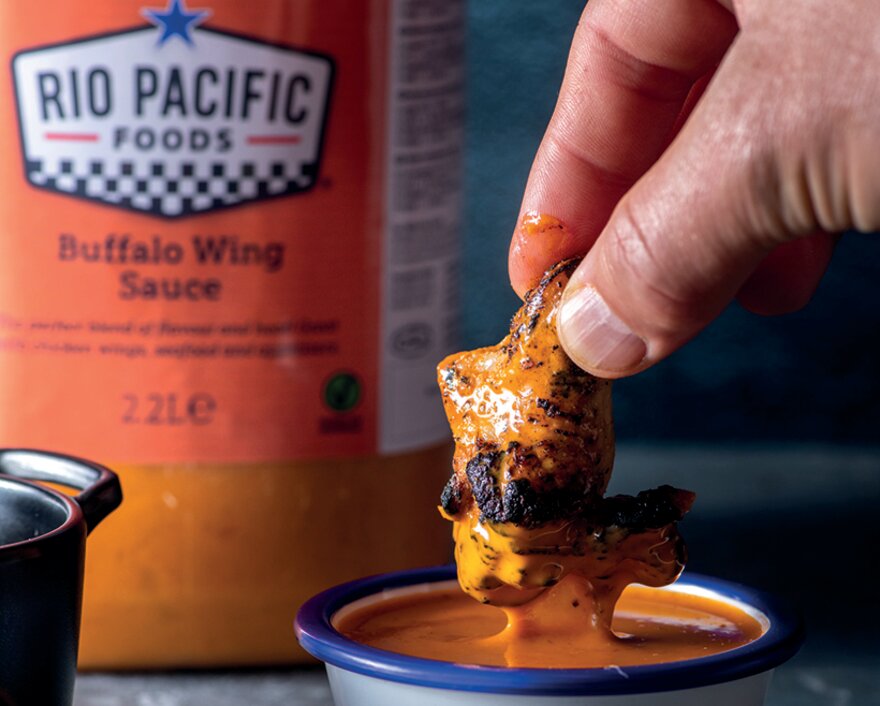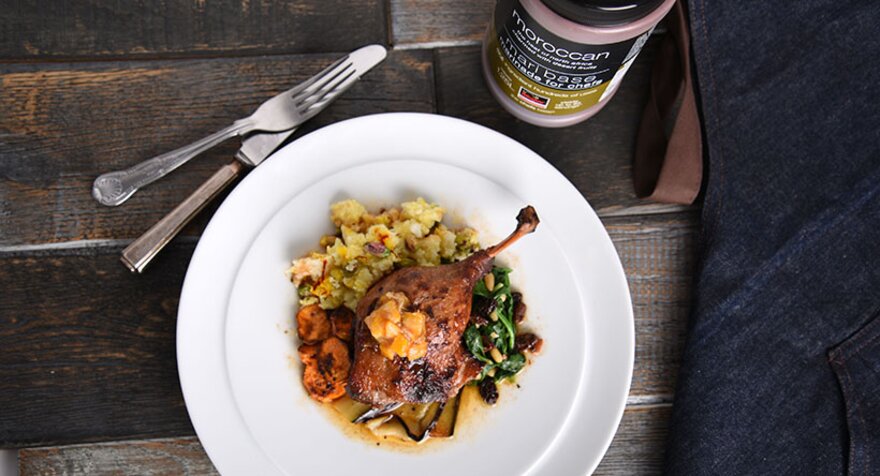Hot honey is the hottest sauce on the market
Diners are increasingly turning up the heat on their meals with the addition of spicy sauces. Here's what's hot right now
Depending on your perspective, Dr Sting's Hot Honey started at a pizza restaurant in Brooklyn or in a kitchen in Nunhead. The pizza restaurant, Barboncino in Franklin Avenue, was where co-founder Ben Lippett first tried it – and the kitchen was where he first made it, having moved back to the city from New York in 2017.
Plenty of food and drink trends have crossed the Atlantic over the years, but not all of them have made the anticipated splash. Hard seltzer, a huge hit among America's pro-booze, anti-calorie contingent, is still awaiting take-off in the UK – but the prospects for Hot Honey, a blend of honey, chilli and vinegar, used as a condiment on all manner of savoury and sweet foods, look brighter. Britons love heat, and they love sweet. It should be a pushover.
Thus far, the signs are promising, if muted. Last summer, burger joint Shake Shack launched a seasonal menu featuring fried chicken sandwiches glazed with hot honey; Fortnum & Mason sells its own version, called ‘Chef's Smoked Chipotle Honey'; and Dr Sting's has collaborated with some of London's hippest small food producers, from Willy's Pies to Ruben's Reubens.
Given the growth of hot sauces in the UK, though, hot honey could soon be very popular indeed. From well-known sauces like sriracha and Frank's Red Hot to Ed Sheeran's recently-launched brand (Tingly Ted's, "a medium hot sauce [that] feels like a warming hug in a bottle – not too hot but just enough to get your taste buds excited"), it's a big and growing market. But is there space for a taste of honey?
Small but mighty
The recipe for Dr Sting's is fairly simple, according to 28-year-old chef Lippett, with three ingredients: blossom honey, two types of dried chilli and cider vinegar. "There's a sweet/heat balance that is really nice," he says. "That's why you often find it on pizzas or something spicy or something that's got a lot of fat. It's really good with dairy – ice cream, for example – or cured meats, too."
Lippett and business partner, 27-year-old designer Jamie Kaye, make the hot honey themselves at a facility in Bermondsey, but they plan to outsource this part of the business soon. It's hard to work full-time jobs and make hot honey, Lippett says, especially when there is a growing need to devote more time to promotion and an increasing volume of orders from wholesale customers. "The demand to make more is really ramping up," he says.
At the moment, the brand is largely London-focused; well-known by those acquainted with the city's ever-changing food scene, but less visible to most of Britain's consumers. Nonetheless, it should have appeal. Beyond the product itself, the branding features a cartoon bee beneath the legend "Nice ‘N Spicy", a reflection of the founders' playful approach to business.
They're very keen to get into more restaurants, having benefited from a number of collaborations since they first made Dr Sting in December 2021. "We're trying to push long-term relationships now," he says, "to get onto menus and stay there. We've been most successful in the pizza market and we're on the menu at some brunch places, and we're about to be available at the Tandoor Chophouse [in Covent Garden]. Hot honey is a really versatile product." Bars, too: "It's really amazing in cocktails –we're really keen to get on some bar menus."
It's far from the only hot honey brand on the market. Hot Fire Honey, made by Black Mountain in Wales, is made with Welsh honey and chillies; Hilltop Hot Honey, also from Wales, is made without vinegar; JD's, named for founder Jade Dawson, is made with jalapeño and spirit vinegar; Wilderbee hot honey, "the UK's first", features on a special at Honest Burgers; and Mike's, the original, created in Brooklyn in 2010, comes in two varieties and features on restaurant menus on both sides of the Atlantic.
Given this level of energy on the production side, it feels like hot honey is ready to move into the mainstream. As you might expect, Lippett is confident it can become as popular as other hot sauces. "I really believe it can become a bit of a staple," he says. "It sits in that hot sauce market, which is crowded and noisy, and you've really got to push to make a mark. It's a really accessible hot sauce, even for people who don't like spicy food."
Like hot sauce, the flavour of hot honey depends on the types of chilli used. If you use fresh chillies like Habañero or Scotch Bonnet, the result can be heady and fruity, and smoked chillies will inevitably give you a much smokier flavour. Then there's the honey: Dr Sting uses a "nice, rich, deep, floral honey", which, Lippett says, is key to the flavour.
A warming world
Demand for spicy food is on the rise, according to Ian Craddock, senior research chef at McCormick. Fifty per cent of respondents to a recent McCormick global consumer poll said that they choose spicy flavours both in and out of home, while 80% said they were open to trying new flavours. So it's no surprise that the heat on Britain's high streets is coming from all over the world. McCormick is responsible for two of the most popular hot sauces available at the moment: Frank's Red Hot – the fastest-growing hot sauce in the UK, according to Craddock – and Cholula, a Mexican hot sauce.
"To tempt customers, make the most of bold and varied flavours, which can help drive appeal and add value for consumers," says Craddock. "Moroccan and Caribbean cuisine is picking up, while Japanese and Hawaiian continues to grow, with the likes of Thai and Korean becoming truly established."
For those looking for a reliable shortcut to piquancy, Major International offers the Mari Base range, which comes in 11 flavours, from Tex-Mex to Caribbean jerk, Korean and Keralan. Gluten-free and water-based, they can be added directly as a marinade or used to create sauces, dips and soups, according to Fergus Martin, development chef at Major International.
"A report by Mintel, ‘World Cuisines UK', found that 81% of consumers were looking for a flavour adventure when dining out," Craddock says. "Ultimately, this focus on flavour is one that can be met by using herbs, spices and natural flavours in recipes and by giving the customer a choice of condiments and sauces to accompany their meal."
There are many ways for operators to give customers the flavour adventure they want. Funnybones Foodservice suggests its Korean BBQ sauce, with its flavours of ginger, garlic, Asian pear and sesame oil for those aiming to climb aboard the flavour express, while more adventurous diners might appreciate their Buffalo Wing Sauce.
"Delicious in a burger, served with kimchi slaw, chilli mayo and stuffed into a golden brioche bun, this versatile condiment also works well with the smoky char of a flaming grill," says Tom Styman-Heighton, development chef. "For operators looking to expand their plant-based options, this vegan-friendly sauce also works wonders to braised tofu dishes. For spice connoisseurs Buffalo Wing Sauce is a must-have staple on any menu. Ideal for dipping, dunking or glazing, Funnybones' recipe uses butter to balance the fiery cayenne pepper base, resulting in a creamy and luxurious texture. Simply toss cooked wings in the sauce and serve for a sizzling appetiser."
Flavour isn't just about heat, of course. High-quality pickled vegetables have become more and more easily available in the past decade as customers grow increasingly open-minded about sourness. Leading the charge has been Vadasz, founded in London in 2011 and owned since 2021 by the Compleat Food Group, which launched it into foodservice last year.
There are five products available for wholesale: kimchi, sauerkraut, garlic and dill pickles, red onion pickles, and super-beet kimchi. "Utilising new and different condiments, pickles and ferments can help chefs tap into the cuisines [that customers want to try]," says Charlie Holland, head of Vadasz. "Pickles can add zing and excitement to dishes and can elevate humble lunchtime staples such as the BLT sandwich or a chicken salad wrap by adding an unexpected twist on well-known flavours. Fermented foods add depth and umami flavour, adding complexity to dishes.
"Health is also a key driver for consumers alongside taste, which, at Vadasz, we're seeing reflected in the increased interest in our natural, fermented products, which offer functional benefits such as promoting gut health, as well as tasting great." Vadasz's garlic and dill pickles are used on the Chicken Shack burger at Shake Shack, where hot honey also made an appearance last summer. Like Dr Sting, Vadasz emerged from London's fertile food scene – so could the former follow the latter into the mainstream? It's hard to tell, but Lippett is confident.
"Once you get a bottle of hot honey into someone's hand and they try it," he says, "the hit rate is pretty good."
Suppliers
Dr Sting's Hot Honey www.drstings.com
Funnybones Foodservice www.funnybones.co.uk
Hilltop Honey www.lovehilltop.com
Hot Fire Honey www.hotfirehoney.co.uk
JD's Hot Honey www.jdshothoney.com
Major International www.majorint.com
McCormick www.mccormick.com
Mike's Hot Honey www.mikeshothoney.com
Vadasz www.vadaszdeli.co.uk
Wilderbee www.wilderkitchenfood.com
Continue reading
You need to create an account to read this article. It's free and only requires a few basic details.
Already subscribed? Log In







